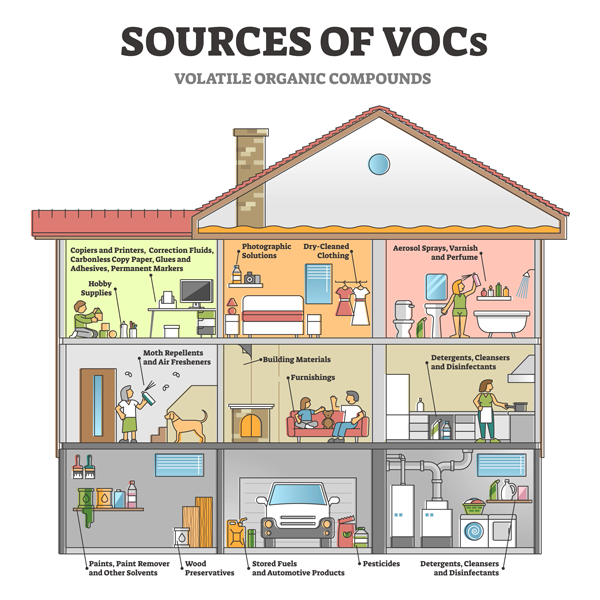Part one: Humidity and humidity sensors
Part two: Carbon dioxide and СО2 sensors
Part three: Volatile organic compounds and VОС sensors
Increased humidity and excess of carbon dioxide are not the only troubles that a person in a poorly ventilated room may face. One of the most dangerous air pollutants are the volatile organic compounds or VOC. It is a collective term used for carbonaceous matter, which have a low boiling point, which results in them easily evaporating at a room temperature and staying in the air as gases. Such substances include chemical compounds of both man-made and natural origins. Most of the odours that we can detect with our sense of smell contain volatile organic compounds. Nevertheless, given that the smell of borscht, cutlets and fried fish may improve the appetite and mood of people dwelling in the premises, the vapours coming from household cleaning products, furniture, office equipment, plastic and other household items can pose a serious threat to a person’s health.
Man-made volatile compounds include organic solvents that are present in such well-known products as glue, aerosols, paints, varnishes, industrial solvents, gasoline, cleaning fluids, etc. For example, paints and solvents, cosmetic products, aerosol sprays, detergents and office stationery are the source of such volatile compounds as benzene, formaldehyde, phenol, limonene, esters, alkanes, aldehydes, silicones and others. An increased concentration of some VOCs, even for a short period of exposure, can cause irritation of the eyes and respiratory tract, headache and nausea, exacerbation of chronic diseases. Volatile organic compounds are not very toxic at low concentrations, but long-term exposure can adversely affect a person’s health.
Children, elderly and especially susceptible people are the categories that most often suffer from exposure to man-made VОСs. For those categories of people, volatile organic compounds cause respiratory, allergic and immune responses in the body. The most common symptoms include eye, nose, and throat irritation, headaches, loss of coordination, nausea, liver, kidney, and central nervous system damage. Some VOCs are suspected or known as oncogenic.
 SOLUTION. Air quality sensors (VOC sensors) allow identifying the level of air pollution with volatile organic compounds. It is fairly high-tech equipment that is used in residential, industrial and public premises with large crowds such as schools, offices, shopping malls, public catering places, industrial facilities, etc. Same as hygrometers and СО2 sensors, VOC sensors may be both standalone devices and integrated elements of ventilation equipment. The latter option allows using ventilation equipment as efficiently and rationally as possible by turning it on and changing its operating modes depending on the level of air pollution with volatile organic compounds.
SOLUTION. Air quality sensors (VOC sensors) allow identifying the level of air pollution with volatile organic compounds. It is fairly high-tech equipment that is used in residential, industrial and public premises with large crowds such as schools, offices, shopping malls, public catering places, industrial facilities, etc. Same as hygrometers and СО2 sensors, VOC sensors may be both standalone devices and integrated elements of ventilation equipment. The latter option allows using ventilation equipment as efficiently and rationally as possible by turning it on and changing its operating modes depending on the level of air pollution with volatile organic compounds.
The self-calibrating air quality sensor DPWQ30600 with a microprocessor control is used for quantitative assessment of air saturation with contaminated gases and oxidizable vapors. Such contaminants may be cigarette smoke; solvent, paint, glue and detergent vapours; human waste, which come out with exhaled air, sweat; and so on. When the set level of air pollution is reached, the ventilation system is turned on (or switches to a more efficient mode), as a result of which more efficient ventilation occurs with minimal energy consumption. The sensor has 2 analogue outputs (0-10 V and 4-20 mA), which allow stepless control of the fan speed with an EC motor. With stepless control the fan speed is changed in proportion to air quality changes.
We have named three most common sources of indoor air pollution and its quality degradation, each of which poses a specific threat to a person’s health. Usually, a person cannot independently identify the level of pollution of the air he breathes and, accordingly, take the necessary measures in time. This work can be performed by various sensors that monitor the air parameters and, when they reach the set limit values, turn on the ventilation system or increase its performance. Therefore, the main task of exchanging the polluted air with fresh and clean air and ensuring a comfortable microclimate within the premises falls on ventilation equipment.
An optimal solution in this situation may be the utilization of state-of-the-art VENTS VUT air handling units. These units represent leading edge technology of air handling units, which ensure not only proper air exchange, but also air quality control and its treatment. Such units are equipped with heat and moisture exchangers, filters of various purification degree, as well as with state-of-the-art A21 controller allowing units integration into the Smart Home system or Building Management System (BMS) and to control the units from anywhere via the Internet or VENTS AHU mobile app. Ventilation units equipped with air quality sensors ensure efficient and cost-effective operation of the equipment in automatic mode depending on the air pollution parameters and guarantees the user a comfortable microclimate 24/7.